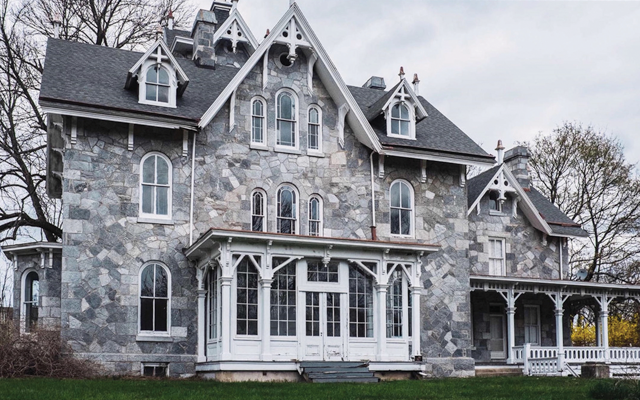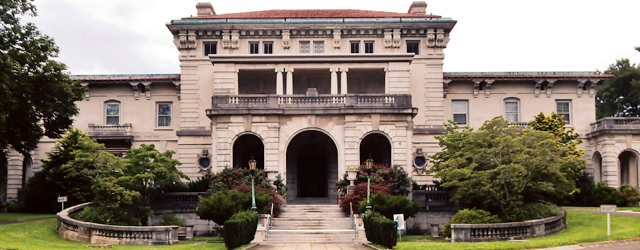Photo (above): William L. Elkins built Elstowe Mansion in 1898. His neighbors along the Old York Road included Gilded Age millionaires: John B. Stetson, John Wanamaker, Jay Cooke and Peter A. B. Widener. In 1932, the Dominican Sisters of St. Catherine de Ricci purchased it. The nuns still own the mansion although it is currently up for sale again.
Reviewed By Marita Krivda Poxon
Philadelphia Mansions:
Stories and Characters Behind the Walls
By Thom Nickels
Charleston, SC
The History Press, 2018
ISBN: 9781625859518
$21.99
For sale:
www.arcadiapublishing.com/Products/9781625859518
Thom Nickels has published another book on a topic which is very dear to his heart and soul, great architecture in his hometown, Philadelphia. “Philadelphia Mansions: Stories and Characters Behind the Walls” is Nickels’ 13th book. It combines his encyclopedic knowledge of the city’s history with his inordinate ability to discover unusual, quirky little known facts about the owners or builders of homes he has grown to love or hate.
Like all his books this one is not mere architectural journalism. It is loaded with personal glimpses into fabled mansions, homes perched inside skyscrapers and center city townhomes of the famous. From his childhood onwards, Nickels has written architectural criticism and won the 2005 Philadelphia AIA Lewis Mumford Architecture Journalism Award.
The backbone of this recent book is formed from essays that have been published online in his blog over a period of years. These shorter pieces along with new essays are stitched together masterfully in five chapters.
The book starts with Fairmount Park’s Strawberry Mansion and ends with Loch Aerie Mansion in Frazer, an 836-acre estate which was nearby Nickels’ childhood home. Nickels’ voice comes through loud and clear and powers every page. He writes about buildings not in the way an academic historian would but in the way an opinionated essayist like Susan Sontag writes.
Nickels hits the nail on the head on controversial issues like the “President’s House That’s Not a President’s House” where his contrarian viewpoint looks to some to be politically incorrect. He calls the 2009 demolition of Bryn Mawr’s 17,500 square-foot Spanish Gothic La Ronda a tragedy for historic preservation and slams the Lower Merion Historical Commission for tacit complicity.
At one point or another, he surely alienates just about every one of his readers but his intelligence keeps these same readers engaged. His current book continues his unique way of providing illuminating insights on mansions, owners and architects wrapped up with commentary loaded with trigger issues that can get under the reader’s skin.
Nickels tells the story of Elstowe Mansion known to many as the Dominican Retreat House, a Horace Trumbauer designed Italian Renaissance Revival, Gilded Age masterpiece built in 1898 on forty-two acres in Elkins Park. The Elkins family sold the property to the Dominican Sisters of St. Catherine de Ricci in 1932 who ran wonderful religious retreats there until 2009. However, Nickels speculates on the demise of the retreat house.

Thom Nickels’ boyhood home in Frazer, Pa. was very near Loch Aerie Mansion. Nickels devotes the book’s last chapter to Loch Aerie. He recounts how William E. Lockwood, the millionaire manufacturer of paper collars for men, hired architect Addison Hutton in 1864 to build his Italianate, Victorian from locally quarried blue limestone. Originally the estate sat on 836 acres.
He blames the Second Vatican Council of 1962 for devastating Catholicism including its liturgy and architecture concluding: “It is no wonder, then, that the Dominican Retreat House closed its doors, since religious retreats were seen by many as a thing of the past, just as William L. Elkins’ estate was eventually seen as too grandiose to be livable.”
Throughout the book are stories of Nickels meetings with well-known Philadelphians. Particularly memorable is when he visited with Mother Divine for an elaborate Sunday dinner party at her home, Woodmont, an 1892 French Gothic mansion set on 72 acres in Gladwyne.
The mansion is the home base of the Peace Mission Movement started by Father Divine in 1919 in Sayville, New York. Nickels calls his experience “the Real Philadelphia Story” extolling the weirdness of this formal dinner party where congregants dressed in Peace Mission uniforms clapped their hands, sang hymns and listened to a recorded sermon of the long-dead Father Divine.
Nickels will give lectures this fall on “Philadelphia Mansions” at the American Catholic Historical Society located at 263 South 4th Street in Society Hill (www.amch.org/events) as well as the Loch Aerie Mansion in Frazer under the sponsorship of the Tredyffrin Historic Preservation Trust. (http://tredyffrinhistory.org). Dates not set yet for these lectures.

